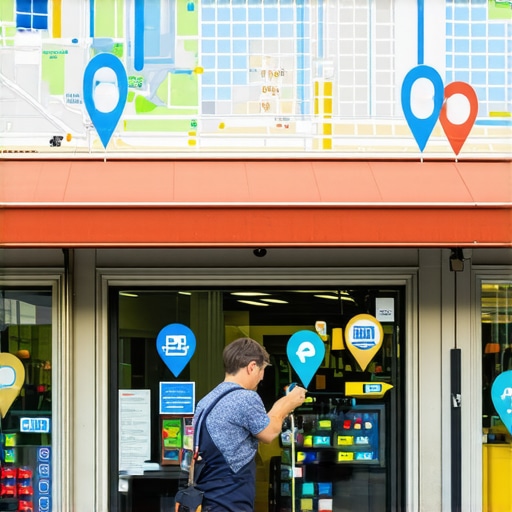
Top GMB Cleanup Strategies for Better Local Map Pack Visibility in 2024
My Journey to Mastering GMB Cleanup for Local Success
As a local business owner, I quickly learned that my Google My Business (GMB) profile could make or break my visibility in the crowded local map pack. I remember the first time I noticed my competitors consistently ranking higher despite having similar services. That was my wake-up call to dive deep into GMB cleanup strategies. Over time, I discovered that a well-maintained, clean GMB profile isn’t just about aesthetics—it’s essential for boosting local rankings in 2024.
Why GMB Cleanup Is More Than Just Fixing Errors
In my early days, I thought fixing basic info errors was enough. But as I dug further, I realized that managing duplicate listings, outdated info, and inconsistent NAP data was crucial to improve my local SEO. According to Moz, consistent local citations and accurate listings significantly impact your visibility in local searches. I started auditing my GMB profile regularly, removing duplicates, and ensuring all information was up-to-date, which gradually improved my rankings.
My Favorite GMB Cleanup Tactics That Really Work
One of the first tactics I adopted was verifying ownership of my listings and claiming all existing profiles. This control allowed me to streamline updates and eliminate conflicting information. I also focused on removing duplicate listings—an often overlooked but powerful step. I used tools like BrightLocal and Whitespark to identify duplicates and inconsistent citations. These efforts paid off when I saw my local map pack visibility increase after implementing consistent NAP data across all directories.
How to Repair GMB Signals for a Stronger Local Presence
Beyond cleanup, signal repair is critical. I learned that optimizing categories, adding high-quality photos, and collecting genuine reviews boosts signal strength. I also started engaging with my audience through Google Posts and responding to reviews, which Google favors. For a deep dive into signal repair techniques, I recommend checking out this resource. These strategies helped me elevate my local rankings and attract more customers.
What’s the most challenging part of GMB cleanup in 2024?
Honestly, keeping track of all profiles and ensuring consistency across platforms is daunting. However, tools like Moz Local and SEMrush have made this process more manageable. Do you struggle with duplicate listings or inconsistent data? Share your experiences—I’d love to hear how you’re tackling these issues!
If you’re serious about dominating your local market, I highly recommend exploring comprehensive GMB cleanup and signal repair strategies. They’re game-changers, especially in a competitive landscape. For more insights, visit this article and start optimizing today!
Unlocking the Power of GMB Signal Repair for Local SEO Success
As local SEO becomes increasingly competitive, understanding the nuanced strategies behind GMB signal repair can give you an edge over your rivals. Beyond basic cleanup, expert practitioners focus on optimizing every aspect of their GMB profile to ensure Google perceives it as authoritative and trustworthy. This involves not only fixing erroneous data but also reinforcing signals that influence ranking factors, such as reviews, categories, and engagement metrics.
How Do You Prioritize Signal Repair Tasks for Maximum Impact?
Prioritization is key. Start by auditing your GMB profile thoroughly—use tools like this resource to identify critical issues such as duplicate listings or inconsistent NAP data. Once identified, focus on high-impact areas: authentic reviews, accurate categories, and comprehensive business descriptions. These signals directly affect your visibility in the local map pack and are often overlooked in favor of superficial fixes.
What Role Do Reviews Play in Signal Reinforcement?
Reviews are arguably the most influential signals for local rankings. They not only bolster credibility but also provide fresh content for Google to index. Encouraging satisfied customers to leave detailed reviews can significantly enhance your local signal strength. Remember, responding to reviews actively demonstrates engagement and signals to Google that your business values customer feedback. Incorporate review management into your ongoing signal repair strategy to maintain a steady flow of positive, relevant reviews.
Can Optimizing Business Categories and Attributes Boost Rankings?
Absolutely. Precise category selection helps Google understand your business niche better, which in turn improves your chances of appearing in relevant local searches. Additionally, updating attributes—such as delivery options, outdoor seating, or Wi-Fi availability—provides detailed signals that match user search intent. Regularly reviewing and refining these categories and attributes ensures your profile remains aligned with the latest local search trends. For detailed guidance on this, explore this article.
How Can I Integrate Signal Repair into My Ongoing Local SEO Strategy?
Integrating signal repair into your broader SEO efforts involves a systematic approach. Regular audits, leveraging automation tools, and staying updated with Google’s algorithm changes are essential. Consistent profile updates, proactive review management, and engagement through Google Posts help sustain signals that Google values. For a comprehensive plan, review this guide on scaling your signal repair efforts effectively.
Are you tracking your GMB signals with the right tools? Effective monitoring enables you to identify issues early, allowing for prompt repairs that maintain or improve your rankings. Sharing your experiences or questions can help others refine their approach—leave a comment below or suggest other topics you’d like to see explored!
Mastering the Art of GMB Signal Repair: My Personal Insights and Advanced Strategies
Over the years, I’ve come to realize that GMB signal repair isn’t just about fixing surface-level issues; it’s a nuanced process that, when done correctly, can redefine your local rankings. One of the most overlooked aspects is understanding the subtle interplay between various signals—reviews, categories, photos, and engagement metrics—and how they collectively influence Google’s perception of your business. I remember a time when I thought optimizing reviews alone would do the trick, but I soon discovered that a holistic approach yields far better results.
Why Deep Signal Optimization Matters More Than Ever in 2024
The local search landscape has become increasingly competitive. Google’s algorithm now places significant weight on trust signals, consistency, and user engagement. According to Moz, maintaining a consistent NAP (Name, Address, Phone) across all platforms is foundational, but integrating this with high-quality reviews, relevant categories, and engaging photos creates a powerful ecosystem of signals that boost your visibility. My experience shows that neglecting even one element can leave your profile vulnerable to competitors who are investing in comprehensive signal repair strategies.
Advanced Tactics for Signal Reinforcement That I’ve Personally Tested
One tactic that transformed my local rankings was leveraging Google Posts strategically. By consistently posting relevant updates, offers, or news, I provided Google with fresh content, reinforcing engagement signals. Additionally, I started actively managing reviews—not just responding but encouraging detailed feedback from satisfied customers. This approach increased the quality and quantity of my reviews, which, as this resource suggests, significantly impacts local rankings.
On the technical side, I used tools like Whitespark to identify citation inconsistencies, then meticulously corrected them. This process may seem tedious, but the payoff was evident: my profile became more trustworthy and authoritative in Google’s eyes.
Nuances of Optimizing Business Attributes and Categories for Maximum Impact
One subtle but impactful step is refining your business categories and attributes. For instance, if you’re a restaurant, selecting precise categories like “Italian Restaurant” versus broader ones like “Restaurant” can make a considerable difference. Updating attributes—such as outdoor seating, delivery options, or Wi-Fi—provides granular signals that align with user intent. In my journey, I found that regularly revisiting and fine-tuning these elements kept my profile aligned with evolving search trends. For detailed guidance, I recommend exploring this article.
Integrating Signal Repair into a Continuous Local SEO Workflow
To truly see lasting results, signal repair must be part of a continuous process. I set up monthly audits using tools like SEMrush and Moz Local to monitor for new issues—duplicate profiles, inconsistent NAP, outdated photos, or new reviews that need responding to. This proactive approach ensures my GMB profile remains optimized amid ongoing local search algorithm updates. Moreover, engaging customers to leave reviews and updating content regularly keeps my signals fresh and relevant.
What Are the Hidden Challenges of GMB Signal Repair That You Might Not Expect?
One challenge I faced was dealing with suppressed or unverified reviews, which can happen due to Google’s filters. It requires patience and strategic review management to ensure genuine feedback isn’t lost. Additionally, managing multiple locations or service areas complicates consistency, demanding meticulous oversight. These hurdles underscore the importance of having a well-structured local SEO system—something I’ve refined through trial and error. If you’re navigating similar issues, sharing your experiences might help others learn faster. And for a deeper dive into these complexities, check out this comprehensive guide.
Harnessing the Power of Data-Driven Signal Optimization for Local Search Triumph
In my ongoing quest to refine GMB strategies, I’ve come to appreciate the critical role of meticulous data analysis. Leveraging tools like this resource has enabled me to track nuanced shifts in ranking signals, identify emerging issues, and preemptively address potential setbacks. The key lies in integrating advanced analytics into your routine—monitoring citation consistency, review influx patterns, and photo engagement metrics—transforming raw data into actionable insights that propel your local visibility to new heights.
The Art of Strategic Review Acquisition and Management
Beyond simply accumulating reviews, I focus on cultivating a steady stream of authentic, detailed feedback. This involves designing customer experience touchpoints that naturally encourage elaborate reviews—whether through follow-up emails, in-store prompts, or integrated feedback forms. Responding thoughtfully to each review not only enhances customer loyalty but signals to Google that your business maintains active engagement. As Moz emphasizes, reviews are among the most influential local ranking factors, and mastering their strategic acquisition can be a game-changer.
Integrating Semantic Optimization for Enhanced Local Relevance
In my experience, incorporating semantic keywords and contextually relevant terms into your GMB profile elevates your profile’s relevance. This means optimizing descriptions, attributes, and service listings with natural language that mirrors user search queries. Tools like SEMrush assist in identifying high-value long-tail keywords that align with your niche and local intent. By doing so, you craft a profile that resonates with both Google’s algorithms and your target audience, establishing a more authoritative presence in your community’s search landscape.
What Are the Hidden Complexities in Maintaining Cross-Platform Data Consistency?
Ensuring uniformity across all online directories, social platforms, and review sites is a labyrinthine challenge. Discrepancies often creep in due to platform-specific data formats or outdated information, which can dilute your signals and impair rankings. To combat this, I’ve adopted automated synchronization tools that periodically audit and harmonize NAP data, hours, and service details. This meticulous upkeep sustains trust signals and prevents ranking erosion. Have you encountered similar hurdles? Sharing your strategies might unveil new solutions—feel free to comment below.
For a comprehensive understanding of these advanced tactics, I invite you to explore this detailed guide, which delves into sophisticated signal repair methodologies that can elevate your local SEO game.
Refining Business Attributes and Service Areas for Micro-Targeting
Micro-targeting within your GMB profile involves fine-tuning attributes and service areas to match hyper-specific customer intents. For instance, updating attributes like “Wheelchair Accessible” or “Pet-Friendly” can attract niche audiences actively searching for those features. Similarly, delineating precise service areas—down to neighborhoods or districts—helps Google associate your business with highly relevant local queries. Regularly revisiting these granular details ensures your profile remains aligned with evolving search behaviors and demographic shifts.
How Can I Leverage Machine Learning for Continuous Signal Enhancement?
Integrating machine learning tools into your local SEO workflow opens new frontiers for signal refinement. Predictive analytics can identify patterns in review sentiment, engagement timing, and citation performance, allowing for proactive adjustments. For example, AI-driven sentiment analysis can flag declining review quality or emerging negative trends, prompting immediate corrective action. By embracing these cutting-edge technologies, you stay ahead of the curve, ensuring your GMB profile remains resilient and highly optimized amidst algorithm updates. Curious about implementing AI solutions? Let’s connect—your insights could spark innovative strategies in our community.
Things I Wish I Knew Earlier (or You Might Find Surprising)
1. The Power of Consistency
Early on, I underestimated how crucial maintaining consistent NAP data across all platforms was. I thought fixing errors only on my GMB profile was enough, but I soon learned that discrepancies elsewhere could undermine my efforts. Now, I regularly audit my listings to ensure uniformity, which has helped me stay ahead in local rankings.
2. Reviews Are More Than Just Feedback
I used to see reviews as simple customer feedback, but over time, I realized they’re one of the most powerful signals for local SEO. Encouraging detailed reviews and engaging with customers through responses significantly boosts my profile’s authority and visibility.
3. Strategic Category Selection Matters
Choosing broad categories felt easier at first, but I found that pinpointing precise categories aligned better with my services, leading to higher relevance in local searches. Fine-tuning categories and attributes regularly keeps the profile aligned with evolving search behavior.
4. The Hidden Value of Google Posts
Consistently posting updates, offers, or news provides fresh content that signals activity to Google. I’ve seen tangible improvements in engagement and rankings after integrating Google Posts into my routine.
5. Managing Duplicate Listings Is a Game Changer
Identifying and removing duplicates was tedious initially, but it dramatically improved my profile’s trustworthiness. I now use tools like Whitespark to keep duplicates in check and ensure my signals are as strong as possible.
6. Continuous Monitoring Is Essential
Local SEO isn’t a set-it-and-forget-it task. I set monthly audits with tools like Moz Local to catch new issues early. This proactive approach keeps my profile optimized despite frequent algorithm changes.
Resources I’ve Come to Trust Over Time
- Moz Local: A go-to for auditing local citations and maintaining NAP consistency. It’s helped me understand the importance of data accuracy in local SEO.
- BrightLocal: Their tools for review management and citation tracking are invaluable. I recommend it for anyone serious about local rankings.
- SEMrush: For competitive analysis and keyword research, SEMrush keeps me informed about the latest search trends and opportunities.
- Google’s Official My Business Help Center: The authoritative source for platform updates and best practices directly from Google.
Parting Thoughts from My Perspective
Mastering GMB signal repair isn’t just about fixing errors; it’s about building a resilient, authoritative profile that Google trusts. The most valuable lesson I’ve learned is that consistency, engagement, and continuous optimization are the keys to unlocking local success in 2024. If this resonated with you, I’d love to hear your thoughts or experiences. Feel free to share this with someone who’s looking to boost their local visibility or drop a comment below to start a conversation!
,





2 Comments
James Montgomery
Your detailed journey into GMB cleanup resonates deeply with my own experience. Managing multiple listings and ensuring data consistency can indeed be overwhelming, especially with the plethora of tools like Moz Local or Whitespark available. One thing I’ve found particularly helpful is setting up a monthly audit routine using automation tools that sync data across platforms—it helps keep everything aligned and saves a lot of time. The part about optimizing categories and attributes struck a chord; I noticed that refining these elements often leads to noticeable improvements in local rankings. I’m curious, how do you prioritize which signal to repair first when time is limited? For me, review management and NAP consistency always seem to be top priorities. It would be great to hear how others manage their own signal repair workflows to stay ahead in such a competitive space.
Sarah Mitchell
Reading through your journey really struck a chord with me. I’ve also found that the real challenge isn’t just fixing errors but maintaining ongoing consistency across multiple platforms, especially when managing storefronts in different locations. Automating routine audits with tools like Moz Local has been a lifesaver, but I also wonder about the human side—how do you stay motivated to keep checking and updating profiles regularly? I’ve been experimenting with scheduling dedicated weekly review sessions to make it part of my routine, and it seems to work well. Another insight I’d love to hear from others is how they balance between superficial fixes and more in-depth signal building like reviews and photos. Do you focus on high-impact areas first, or go for a full audit across your profile every time? Your approach to prioritization would be fascinating to learn, especially for those of us juggling multiple roles. Thanks for sharing your insights—they’re really motivating!